|
|
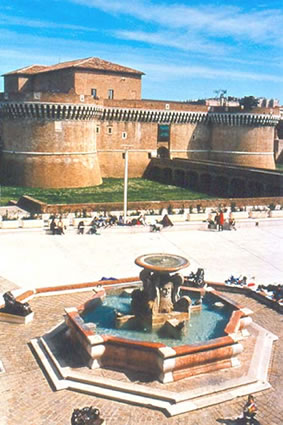 The
"Rocca Roveresca": the first nucleu built by the Romans a tower
to protect the port, in 1350 it was inlarged and became the little
cardinal's Albornoz fortress, under the Urbino dukedom it was
restructureted twice, the first by Sigismondo Malatesta in 1450, then by
Della Roveres, who were Senigallia aboriginal, made here one of the most
beautiful fortress which defended the dukedom bourdary. The whole sorpride
for the harmonious, placid Reinessance air of the rooms normly meant to
the Duca's offices. The Palazzetto Baviera: situated in Del
Duca Square supported at the "Rocca Roveresca" was lived, since
1474 (year of the beginning of Della Rovere rule), by Giovanni Giacomo
Baviera (Duca's parent), who made the restructuration of an fourteenth
century pre-existent house. The stucco of the fifth room of the higher
floor were made by Federico Branbani in 1560 and shows scenes of the old
testaments, the labours of Hercules, episodes of the Troia's war, the
Republica and Imperial Rome. Del Duca Square: Durrounded by "Rocca
Roveresca", Palazzetto Baviera and Del Cuca Palace (which, as
Macchiavelli tell in his most famous book "The Prince" was scene
of the night of S. Valentine dinner where Valantine (to Whome the book is
dedicated), exterminated all of his table companion, princes of the
various rules of the Cantre Italy),laterally moved by the centre of the
square, rise the goose Fountain (now Lyon Fountain) wanted by Francesco
Maria II of Rovere in 1599 remembering the conclusion of the works of the
reclaim by "saline", marshaland tragically malarial city in the
south, and the construction of the waterworks. P The
"Rocca Roveresca": the first nucleu built by the Romans a tower
to protect the port, in 1350 it was inlarged and became the little
cardinal's Albornoz fortress, under the Urbino dukedom it was
restructureted twice, the first by Sigismondo Malatesta in 1450, then by
Della Roveres, who were Senigallia aboriginal, made here one of the most
beautiful fortress which defended the dukedom bourdary. The whole sorpride
for the harmonious, placid Reinessance air of the rooms normly meant to
the Duca's offices. The Palazzetto Baviera: situated in Del
Duca Square supported at the "Rocca Roveresca" was lived, since
1474 (year of the beginning of Della Rovere rule), by Giovanni Giacomo
Baviera (Duca's parent), who made the restructuration of an fourteenth
century pre-existent house. The stucco of the fifth room of the higher
floor were made by Federico Branbani in 1560 and shows scenes of the old
testaments, the labours of Hercules, episodes of the Troia's war, the
Republica and Imperial Rome. Del Duca Square: Durrounded by "Rocca
Roveresca", Palazzetto Baviera and Del Cuca Palace (which, as
Macchiavelli tell in his most famous book "The Prince" was scene
of the night of S. Valentine dinner where Valantine (to Whome the book is
dedicated), exterminated all of his table companion, princes of the
various rules of the Cantre Italy),laterally moved by the centre of the
square, rise the goose Fountain (now Lyon Fountain) wanted by Francesco
Maria II of Rovere in 1599 remembering the conclusion of the works of the
reclaim by "saline", marshaland tragically malarial city in the
south, and the construction of the waterworks. P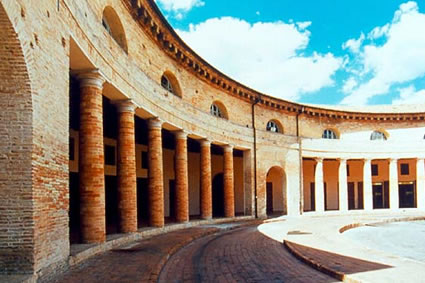 ortici
Ercolani: monumental arches made with white marble which rise on the right
side of Misa river, once place of the mercantile strangers representations,
who used the port of Senigallia for commercial changes with Papal State
(the first half of XIX century through Senigallia is passed the 40% of the
nost important goods from the Papal State, all almost during the period of
the Fair in summer). Foro Annonario: imposing testimony oif the
Marches neo-Classicism, built in 1837, on a draw of the architect Pietro
Ghinelli from Senigallia, planner of theatres, decided to build this
handwork, important for the aesthetics and on the proportion for the food
market of the city and its infrastructure: under the arcade a sequence of
shops most of them are meat shops, at the centre of it there is the big
fish-market. Recently restructureted is a beautiful place, almostas a
theatre's space. Others importan monuments are: the Church of the Cross,
the Cathedral, Lambertina gates, Mastai Palace where Pope Pio IX was born,
Church of the Grazie. ortici
Ercolani: monumental arches made with white marble which rise on the right
side of Misa river, once place of the mercantile strangers representations,
who used the port of Senigallia for commercial changes with Papal State
(the first half of XIX century through Senigallia is passed the 40% of the
nost important goods from the Papal State, all almost during the period of
the Fair in summer). Foro Annonario: imposing testimony oif the
Marches neo-Classicism, built in 1837, on a draw of the architect Pietro
Ghinelli from Senigallia, planner of theatres, decided to build this
handwork, important for the aesthetics and on the proportion for the food
market of the city and its infrastructure: under the arcade a sequence of
shops most of them are meat shops, at the centre of it there is the big
fish-market. Recently restructureted is a beautiful place, almostas a
theatre's space. Others importan monuments are: the Church of the Cross,
the Cathedral, Lambertina gates, Mastai Palace where Pope Pio IX was born,
Church of the Grazie.
The origins
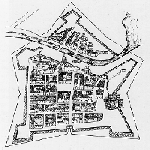 Recentarcheologic
recovery testify Neolithic installation before the epoch of IV century
Before Christ. The Celtic invasion and the installation of Galli Senoni,
between V and IV century before Christ drawed the passage in village
defensive city. T the beginning of III century before Christ, the conquest
by the Romans who made the forst Roman Colony on the Adriatic Sea,
established the transformation of Sena from village in "castrum"
(presumed four-sides structure, regular network of the prefctucability,
city walls, vallum). It still visible the roman structure until the
invasion of the Manfredi's forces in 1264 which, at the time and the
follow centuries, is totally cancelled by the devaluations but also
because the allucial sediments of the Misa: Since XVI century bedore
Christ until the Union of Italy, Sinigaglia has been a very important
commercial centre thanks to the free portm, place of the famous
"fiera of Sinigaglia". Recentarcheologic
recovery testify Neolithic installation before the epoch of IV century
Before Christ. The Celtic invasion and the installation of Galli Senoni,
between V and IV century before Christ drawed the passage in village
defensive city. T the beginning of III century before Christ, the conquest
by the Romans who made the forst Roman Colony on the Adriatic Sea,
established the transformation of Sena from village in "castrum"
(presumed four-sides structure, regular network of the prefctucability,
city walls, vallum). It still visible the roman structure until the
invasion of the Manfredi's forces in 1264 which, at the time and the
follow centuries, is totally cancelled by the devaluations but also
because the allucial sediments of the Misa: Since XVI century bedore
Christ until the Union of Italy, Sinigaglia has been a very important
commercial centre thanks to the free portm, place of the famous
"fiera of Sinigaglia".
From Malatesta to
Roveres
- Is Sigismondo Pandolfo Malatesta, Prince of Fano and Rimini,
the first prince of the city. But what Sigismondo obteined from the
Church in 1450 is a place half-destroyed by the comunal fights, from
Saracn incursion, depopilated by
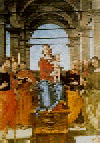 slaughter, gone wilded for desetion of the country. He built
walls, bulwarks repopulate the city. In 1462 he lost the his Rule. In
1474 Pope Sisto IV gae in vic
slaughter, gone wilded for desetion of the country. He built
walls, bulwarks repopulate the city. In 1462 he lost the his Rule. In
1474 Pope Sisto IV gae in vic ariate
to his nephew Giovanni Della Rovere. Leader of mercenary troops as his
successors who will be now at service of the Popes, of the
Serenissima, of the Spain's King and together Reinessance man, he
fortified the walls, let build the Rocca, as th time imposed: the
Turkes are in Adriatic. He gave the start of the long and happy rule
of the Della Rovere, then wonderful Rules of Urbino (1501) ariate
to his nephew Giovanni Della Rovere. Leader of mercenary troops as his
successors who will be now at service of the Popes, of the
Serenissima, of the Spain's King and together Reinessance man, he
fortified the walls, let build the Rocca, as th time imposed: the
Turkes are in Adriatic. He gave the start of the long and happy rule
of the Della Rovere, then wonderful Rules of Urbino (1501)
- Madonna di Senigallia
- (Perugino / Museo: Palazzo Ducale di Urbino)
- Federico Malatesta
- (Museum:Urbino Palace)
His Successors: Francesco Maria I (who became, in 1508, for
eredity, Duke of Urbino)(+1538), Guidobaldo II (+1574), Francesco Maria II
(+1631). In 1631 the city, the most important port of the dukedom, back to
the Churh until the Unit of Italy
-
-
-
 1987
- 1997 -
1998 - 1999 - 2000 1987
- 1997 -
1998 - 1999 - 2000 -
2001 - 2002 - 2003 - 2004 - 2005
-
-
-
-
-
|



 -




|
|


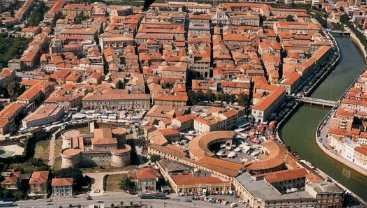



 The
"Rocca Roveresca": the first nucleu built by the Romans a tower
to protect the port, in 1350 it was inlarged and became the little
cardinal's Albornoz fortress, under the Urbino dukedom it was
restructureted twice, the first by Sigismondo Malatesta in 1450, then by
Della Roveres, who were Senigallia aboriginal, made here one of the most
beautiful fortress which defended the dukedom bourdary. The whole sorpride
for the harmonious, placid Reinessance air of the rooms normly meant to
the Duca's offices. The Palazzetto Baviera: situated in Del
Duca Square supported at the "Rocca Roveresca" was lived, since
1474 (year of the beginning of Della Rovere rule), by Giovanni Giacomo
Baviera (Duca's parent), who made the restructuration of an fourteenth
century pre-existent house. The stucco of the fifth room of the higher
floor were made by Federico Branbani in 1560 and shows scenes of the old
testaments, the labours of Hercules, episodes of the Troia's war, the
Republica and Imperial Rome. Del Duca Square: Durrounded by "Rocca
Roveresca", Palazzetto Baviera and Del Cuca Palace (which, as
Macchiavelli tell in his most famous book "The Prince" was scene
of the night of S. Valentine dinner where Valantine (to Whome the book is
dedicated), exterminated all of his table companion, princes of the
various rules of the Cantre Italy),laterally moved by the centre of the
square, rise the goose Fountain (now Lyon Fountain) wanted by Francesco
Maria II of Rovere in 1599 remembering the conclusion of the works of the
reclaim by "saline", marshaland tragically malarial city in the
south, and the construction of the waterworks. P
The
"Rocca Roveresca": the first nucleu built by the Romans a tower
to protect the port, in 1350 it was inlarged and became the little
cardinal's Albornoz fortress, under the Urbino dukedom it was
restructureted twice, the first by Sigismondo Malatesta in 1450, then by
Della Roveres, who were Senigallia aboriginal, made here one of the most
beautiful fortress which defended the dukedom bourdary. The whole sorpride
for the harmonious, placid Reinessance air of the rooms normly meant to
the Duca's offices. The Palazzetto Baviera: situated in Del
Duca Square supported at the "Rocca Roveresca" was lived, since
1474 (year of the beginning of Della Rovere rule), by Giovanni Giacomo
Baviera (Duca's parent), who made the restructuration of an fourteenth
century pre-existent house. The stucco of the fifth room of the higher
floor were made by Federico Branbani in 1560 and shows scenes of the old
testaments, the labours of Hercules, episodes of the Troia's war, the
Republica and Imperial Rome. Del Duca Square: Durrounded by "Rocca
Roveresca", Palazzetto Baviera and Del Cuca Palace (which, as
Macchiavelli tell in his most famous book "The Prince" was scene
of the night of S. Valentine dinner where Valantine (to Whome the book is
dedicated), exterminated all of his table companion, princes of the
various rules of the Cantre Italy),laterally moved by the centre of the
square, rise the goose Fountain (now Lyon Fountain) wanted by Francesco
Maria II of Rovere in 1599 remembering the conclusion of the works of the
reclaim by "saline", marshaland tragically malarial city in the
south, and the construction of the waterworks. P ortici
Ercolani: monumental arches made with white marble which rise on the right
side of Misa river, once place of the mercantile strangers representations,
who used the port of Senigallia for commercial changes with Papal State
(the first half of XIX century through Senigallia is passed the 40% of the
nost important goods from the Papal State, all almost during the period of
the Fair in summer). Foro Annonario: imposing testimony oif the
Marches neo-Classicism, built in 1837, on a draw of the architect Pietro
Ghinelli from Senigallia, planner of theatres, decided to build this
handwork, important for the aesthetics and on the proportion for the food
market of the city and its infrastructure: under the arcade a sequence of
shops most of them are meat shops, at the centre of it there is the big
fish-market. Recently restructureted is a beautiful place, almostas a
theatre's space. Others importan monuments are: the Church of the Cross,
the Cathedral, Lambertina gates, Mastai Palace where Pope Pio IX was born,
Church of the Grazie.
ortici
Ercolani: monumental arches made with white marble which rise on the right
side of Misa river, once place of the mercantile strangers representations,
who used the port of Senigallia for commercial changes with Papal State
(the first half of XIX century through Senigallia is passed the 40% of the
nost important goods from the Papal State, all almost during the period of
the Fair in summer). Foro Annonario: imposing testimony oif the
Marches neo-Classicism, built in 1837, on a draw of the architect Pietro
Ghinelli from Senigallia, planner of theatres, decided to build this
handwork, important for the aesthetics and on the proportion for the food
market of the city and its infrastructure: under the arcade a sequence of
shops most of them are meat shops, at the centre of it there is the big
fish-market. Recently restructureted is a beautiful place, almostas a
theatre's space. Others importan monuments are: the Church of the Cross,
the Cathedral, Lambertina gates, Mastai Palace where Pope Pio IX was born,
Church of the Grazie.
 Recentarcheologic
recovery testify Neolithic installation before the epoch of IV century
Before Christ. The Celtic invasion and the installation of Galli Senoni,
between V and IV century before Christ drawed the passage in village
defensive city. T the beginning of III century before Christ, the conquest
by the Romans who made the forst Roman Colony on the Adriatic Sea,
established the transformation of Sena from village in "castrum"
(presumed four-sides structure, regular network of the prefctucability,
city walls, vallum). It still visible the roman structure until the
invasion of the Manfredi's forces in 1264 which, at the time and the
follow centuries, is totally cancelled by the devaluations but also
because the allucial sediments of the Misa: Since XVI century bedore
Christ until the Union of Italy, Sinigaglia has been a very important
commercial centre thanks to the free portm, place of the famous
"fiera of Sinigaglia".
Recentarcheologic
recovery testify Neolithic installation before the epoch of IV century
Before Christ. The Celtic invasion and the installation of Galli Senoni,
between V and IV century before Christ drawed the passage in village
defensive city. T the beginning of III century before Christ, the conquest
by the Romans who made the forst Roman Colony on the Adriatic Sea,
established the transformation of Sena from village in "castrum"
(presumed four-sides structure, regular network of the prefctucability,
city walls, vallum). It still visible the roman structure until the
invasion of the Manfredi's forces in 1264 which, at the time and the
follow centuries, is totally cancelled by the devaluations but also
because the allucial sediments of the Misa: Since XVI century bedore
Christ until the Union of Italy, Sinigaglia has been a very important
commercial centre thanks to the free portm, place of the famous
"fiera of Sinigaglia". slaughter, gone wilded for desetion of the country. He built
walls, bulwarks repopulate the city. In 1462 he lost the his Rule. In
1474 Pope Sisto IV gae in vic
slaughter, gone wilded for desetion of the country. He built
walls, bulwarks repopulate the city. In 1462 he lost the his Rule. In
1474 Pope Sisto IV gae in vic ariate
to his nephew Giovanni Della Rovere. Leader of mercenary troops as his
successors who will be now at service of the Popes, of the
Serenissima, of the Spain's King and together Reinessance man, he
fortified the walls, let build the Rocca, as th time imposed: the
Turkes are in Adriatic. He gave the start of the long and happy rule
of the Della Rovere, then wonderful Rules of Urbino (1501)
ariate
to his nephew Giovanni Della Rovere. Leader of mercenary troops as his
successors who will be now at service of the Popes, of the
Serenissima, of the Spain's King and together Reinessance man, he
fortified the walls, let build the Rocca, as th time imposed: the
Turkes are in Adriatic. He gave the start of the long and happy rule
of the Della Rovere, then wonderful Rules of Urbino (1501)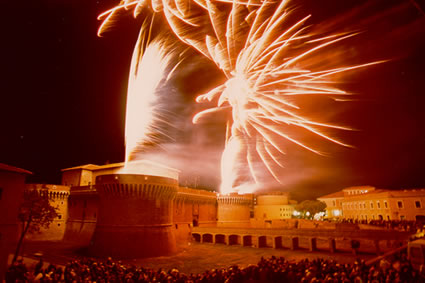
 1987
- 1997 -
1998 - 1999 - 2000
1987
- 1997 -
1998 - 1999 - 2000 

